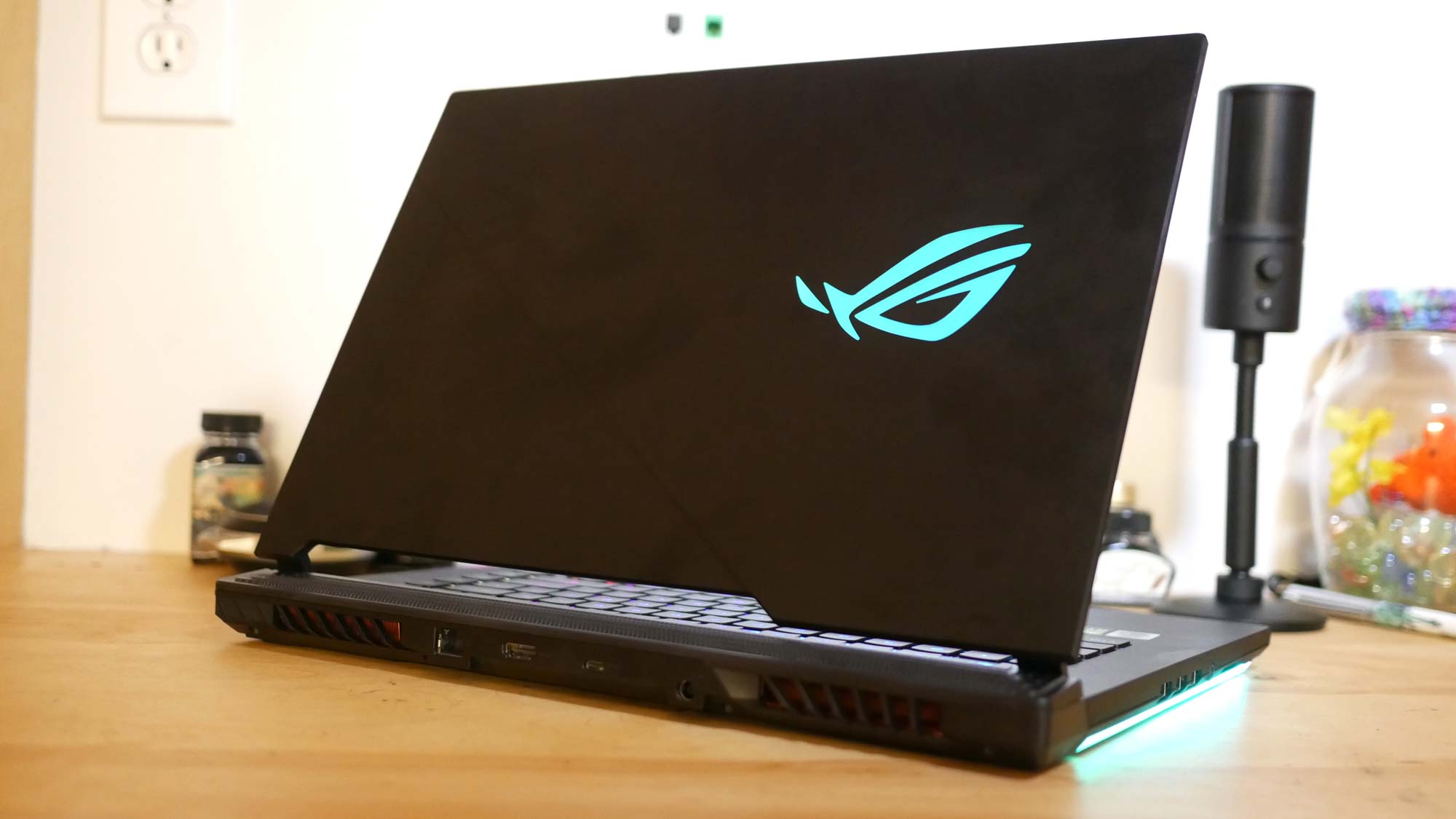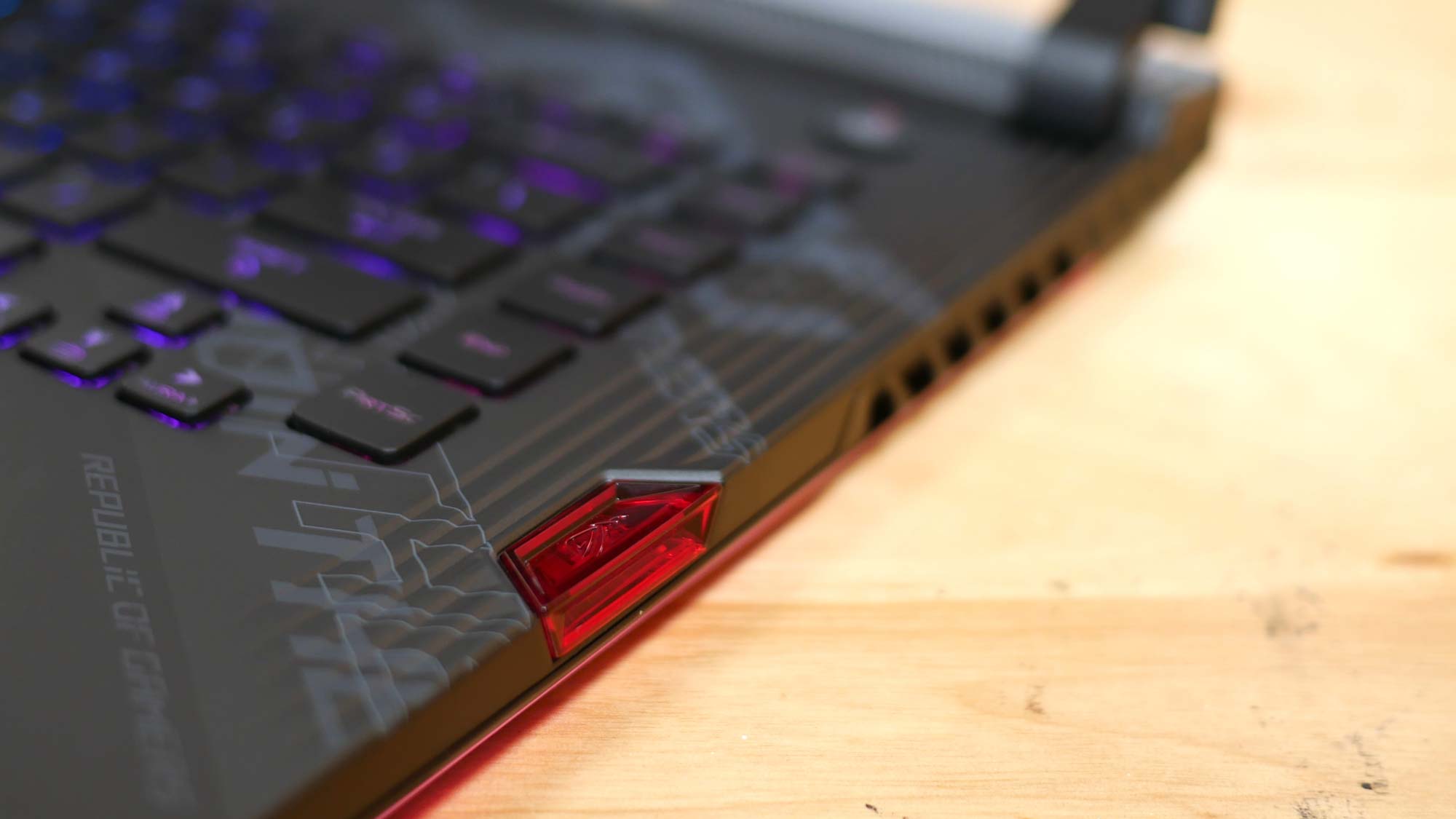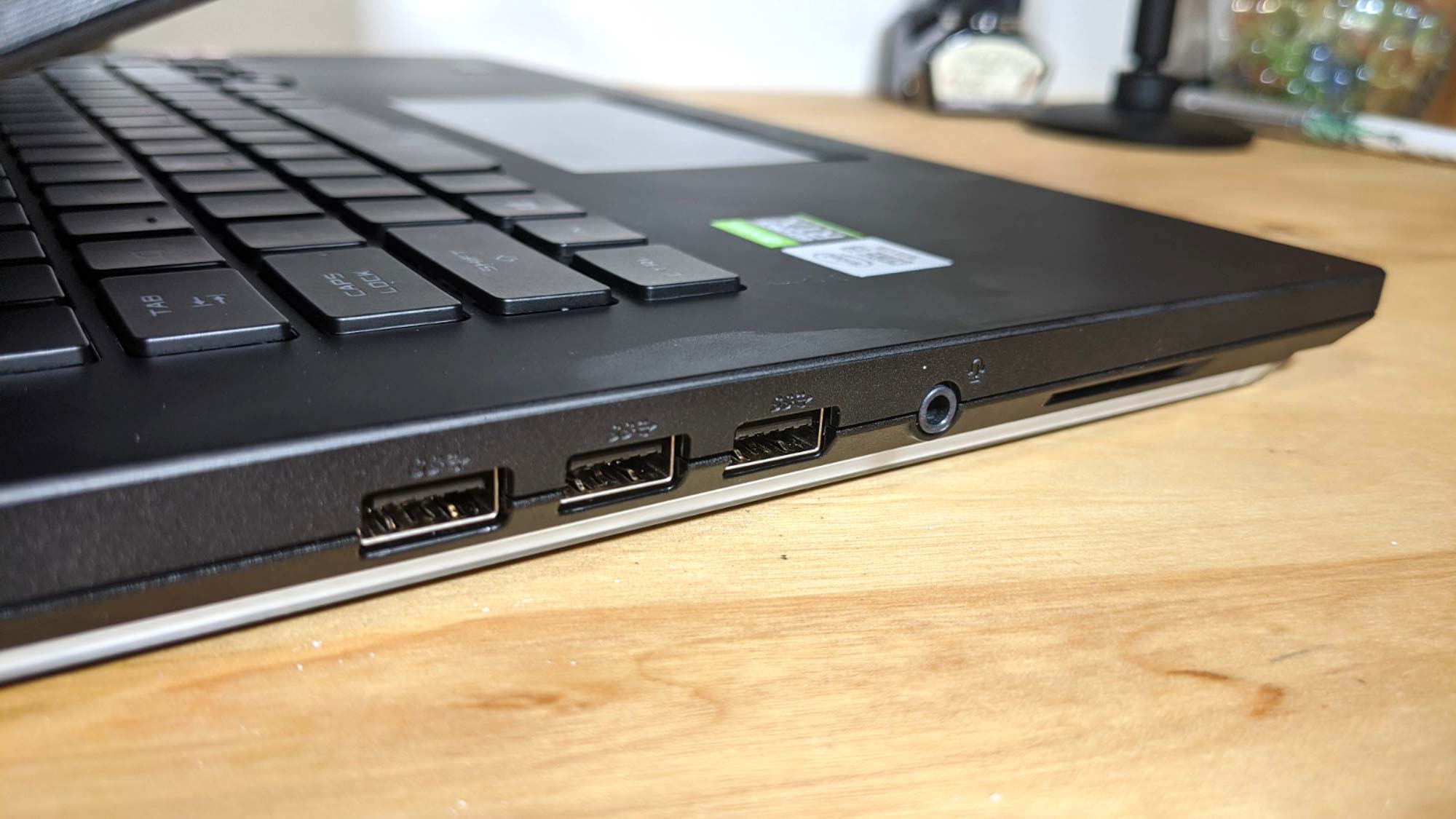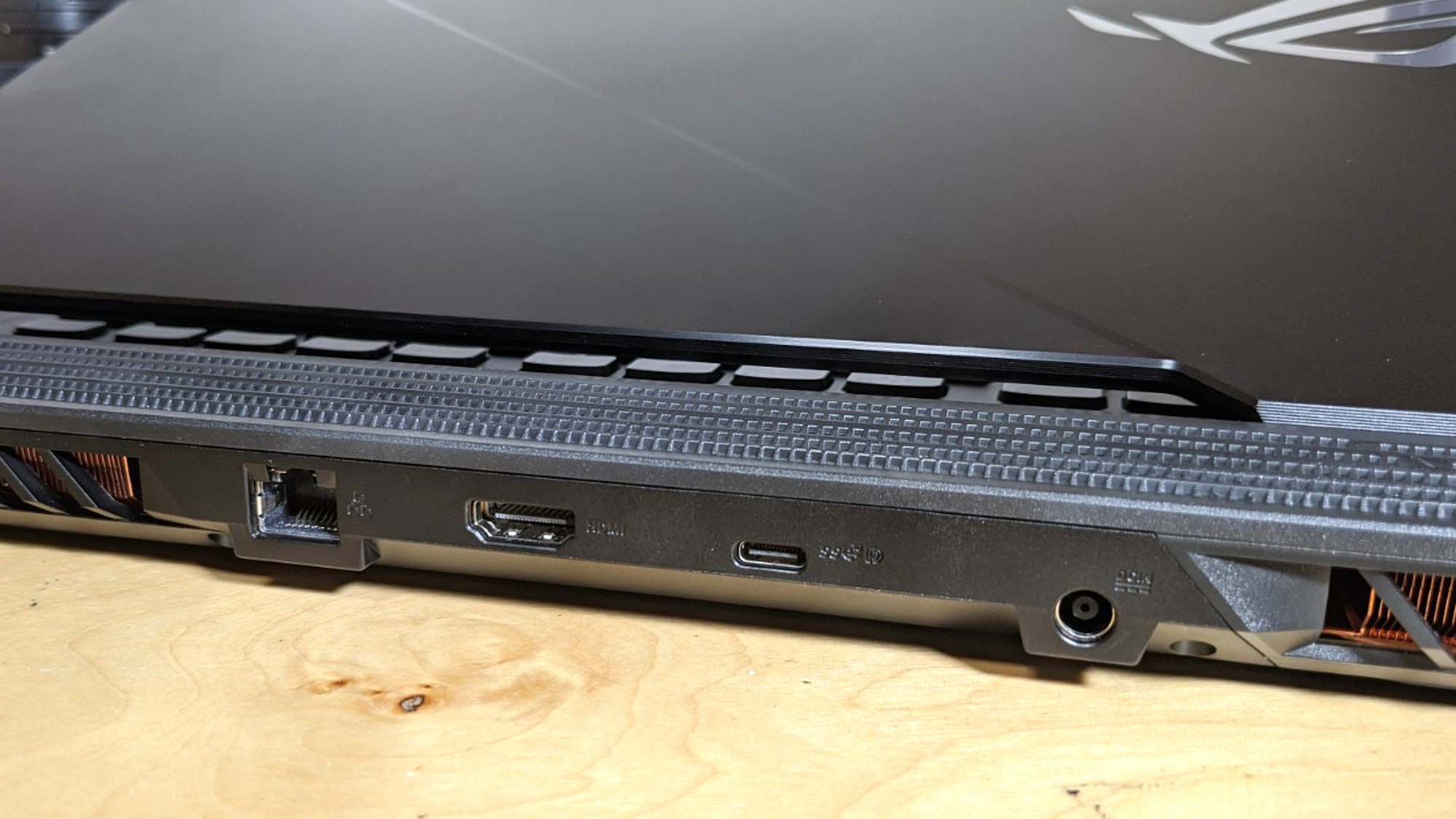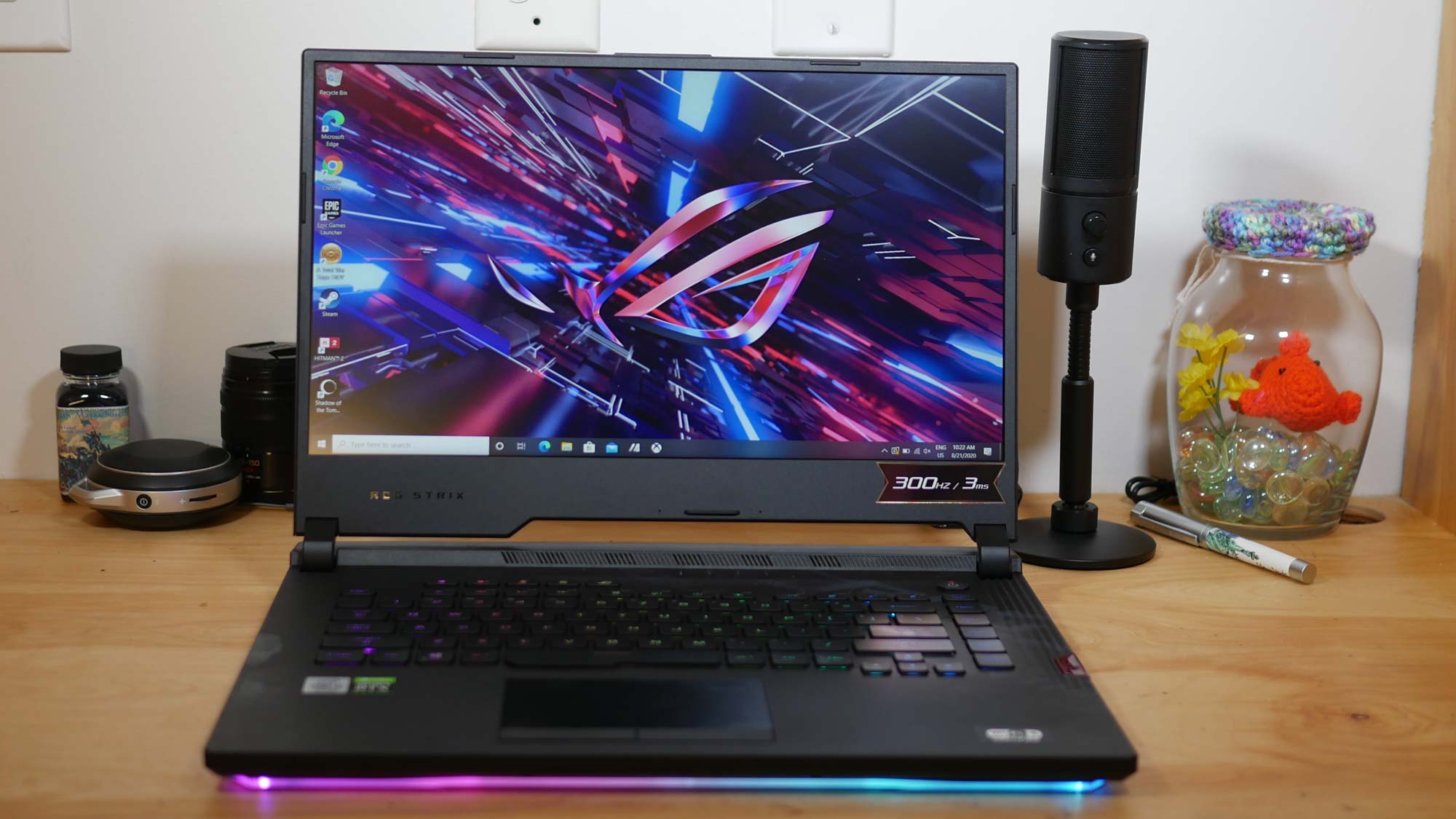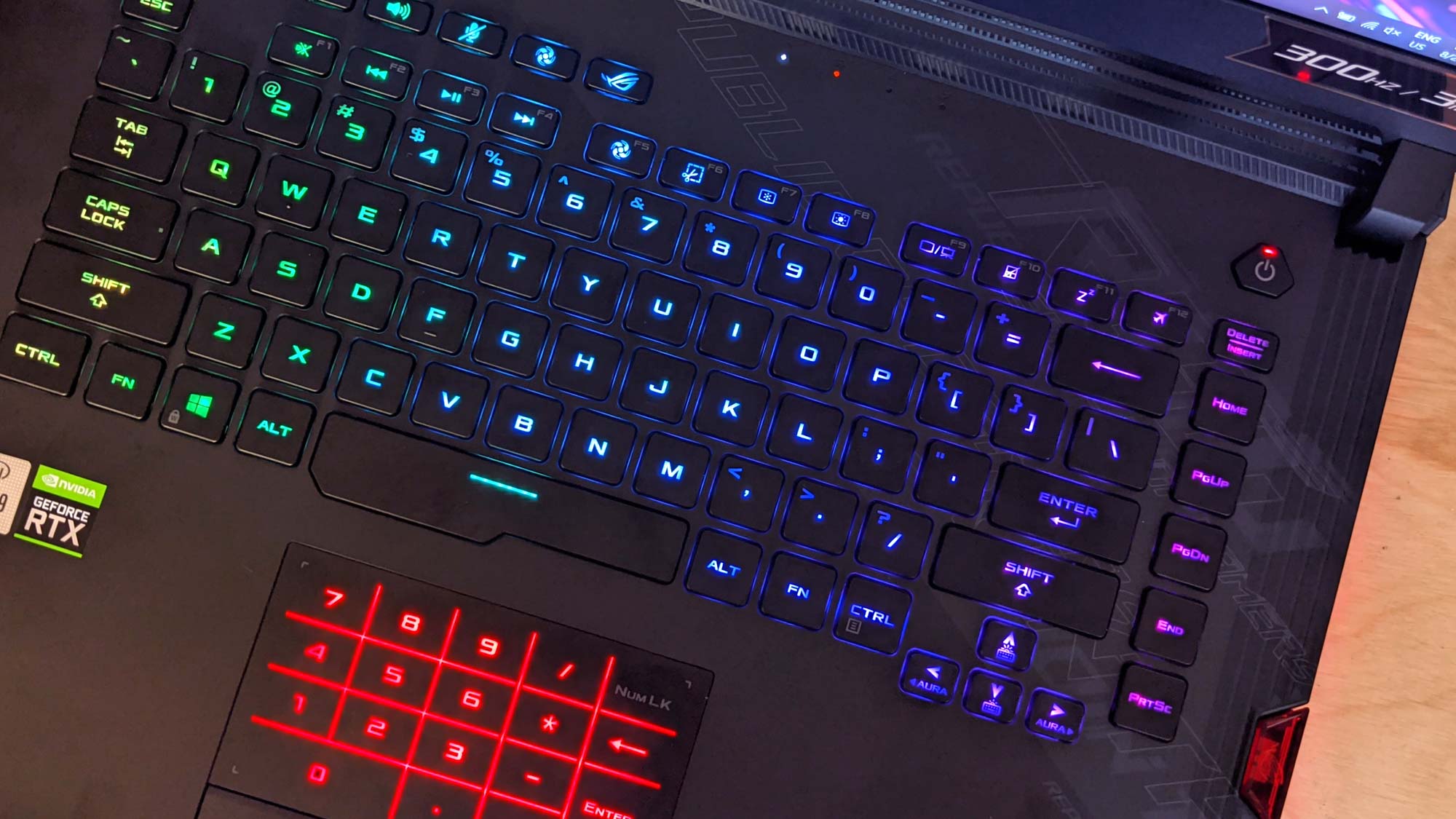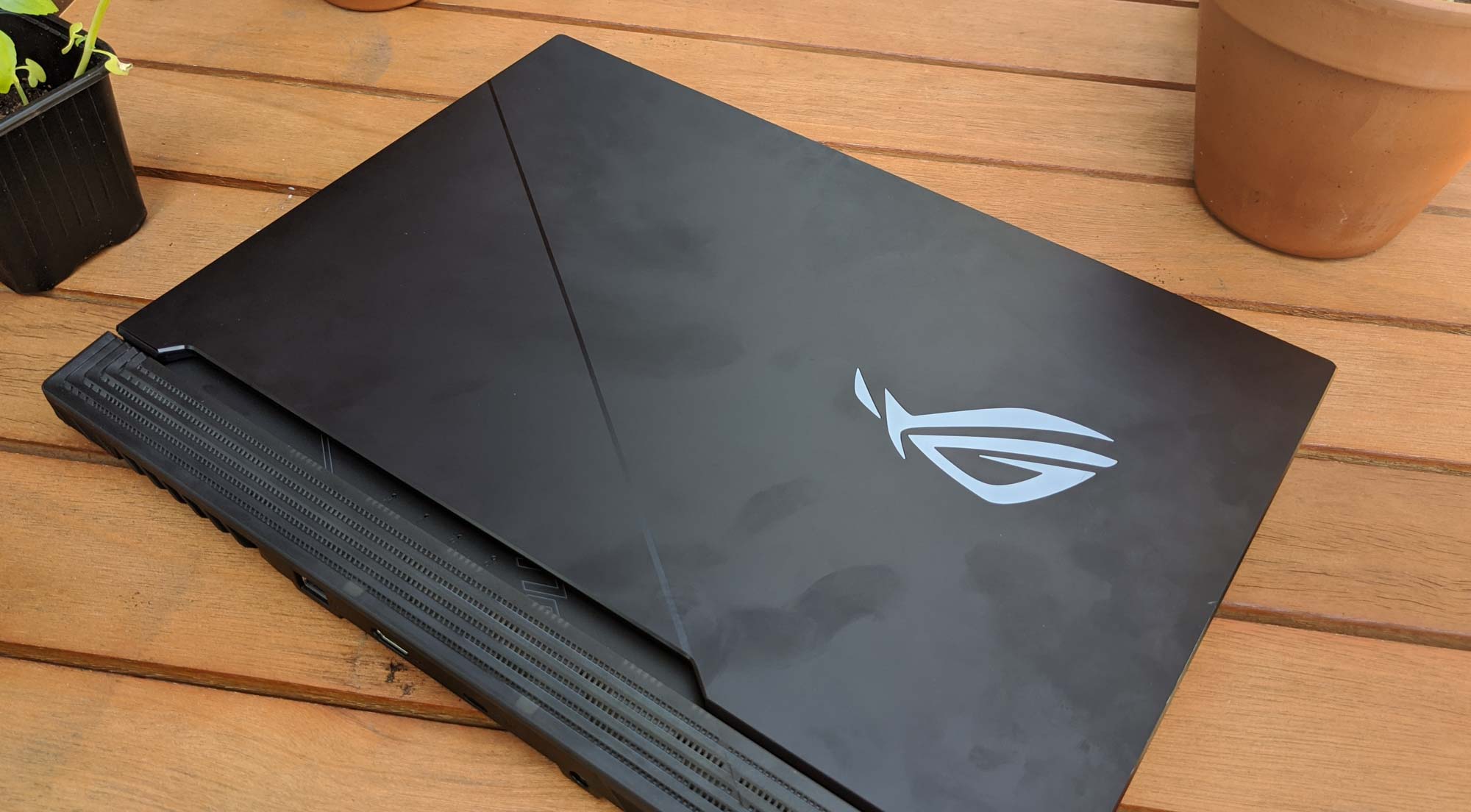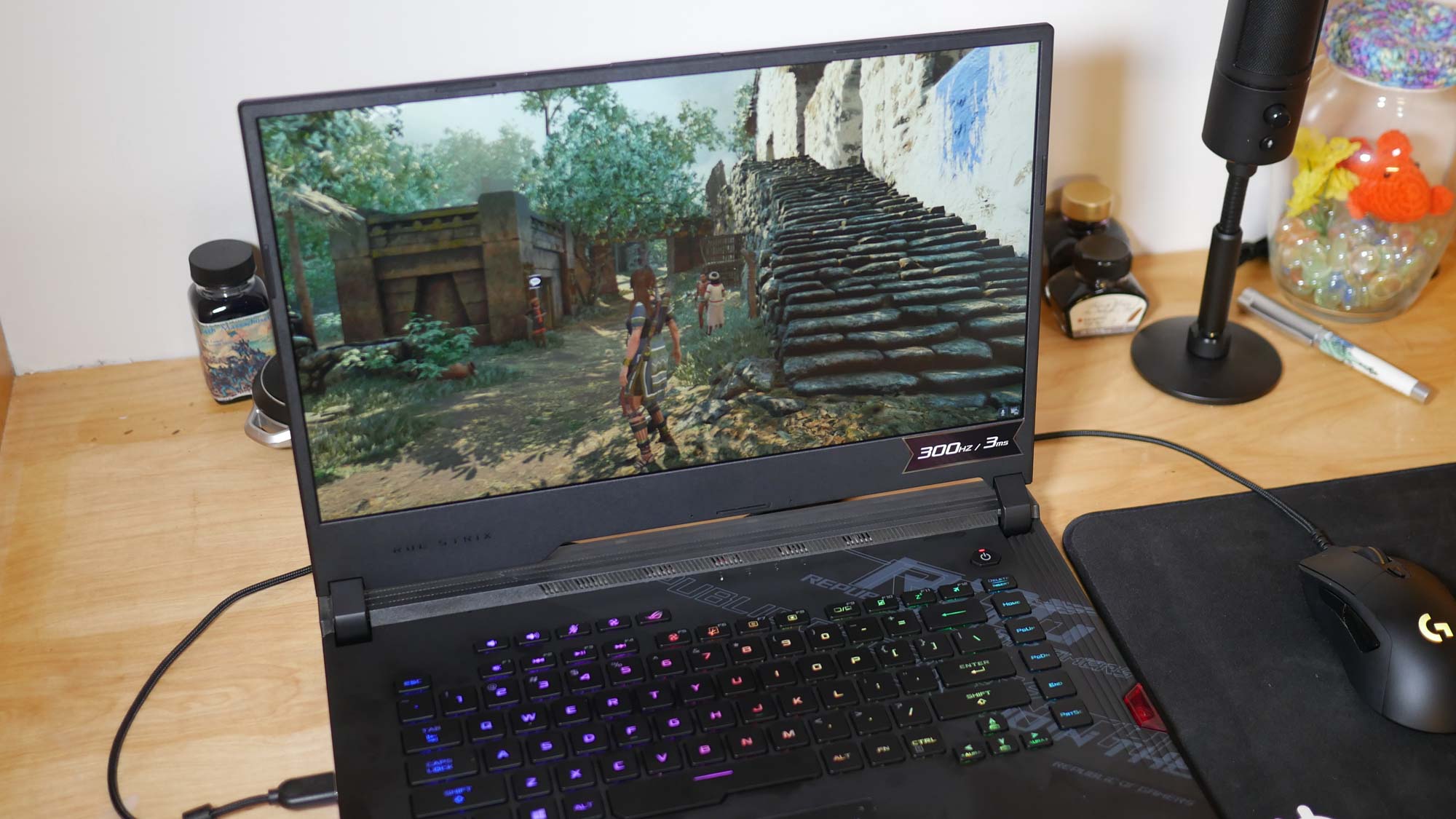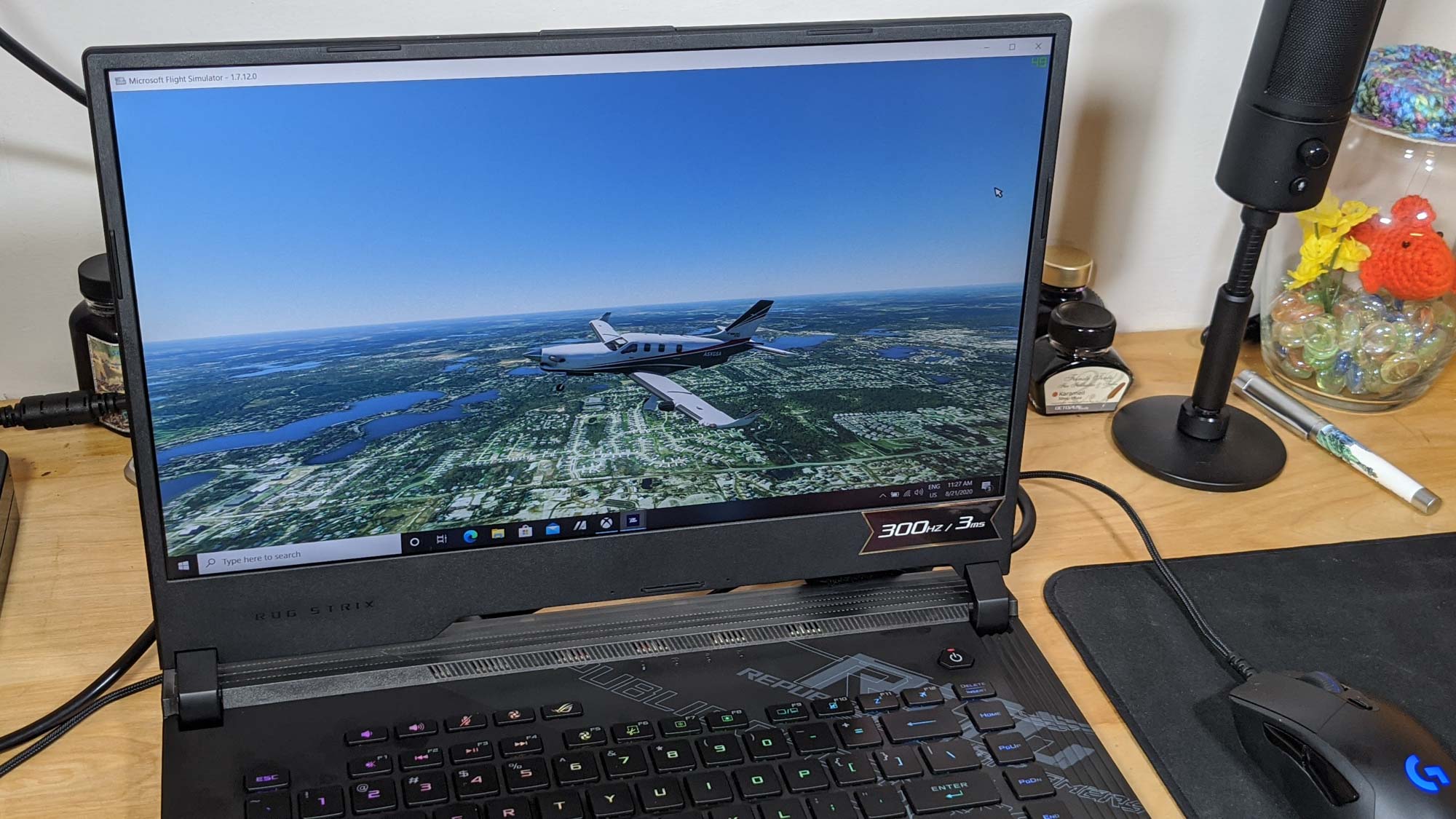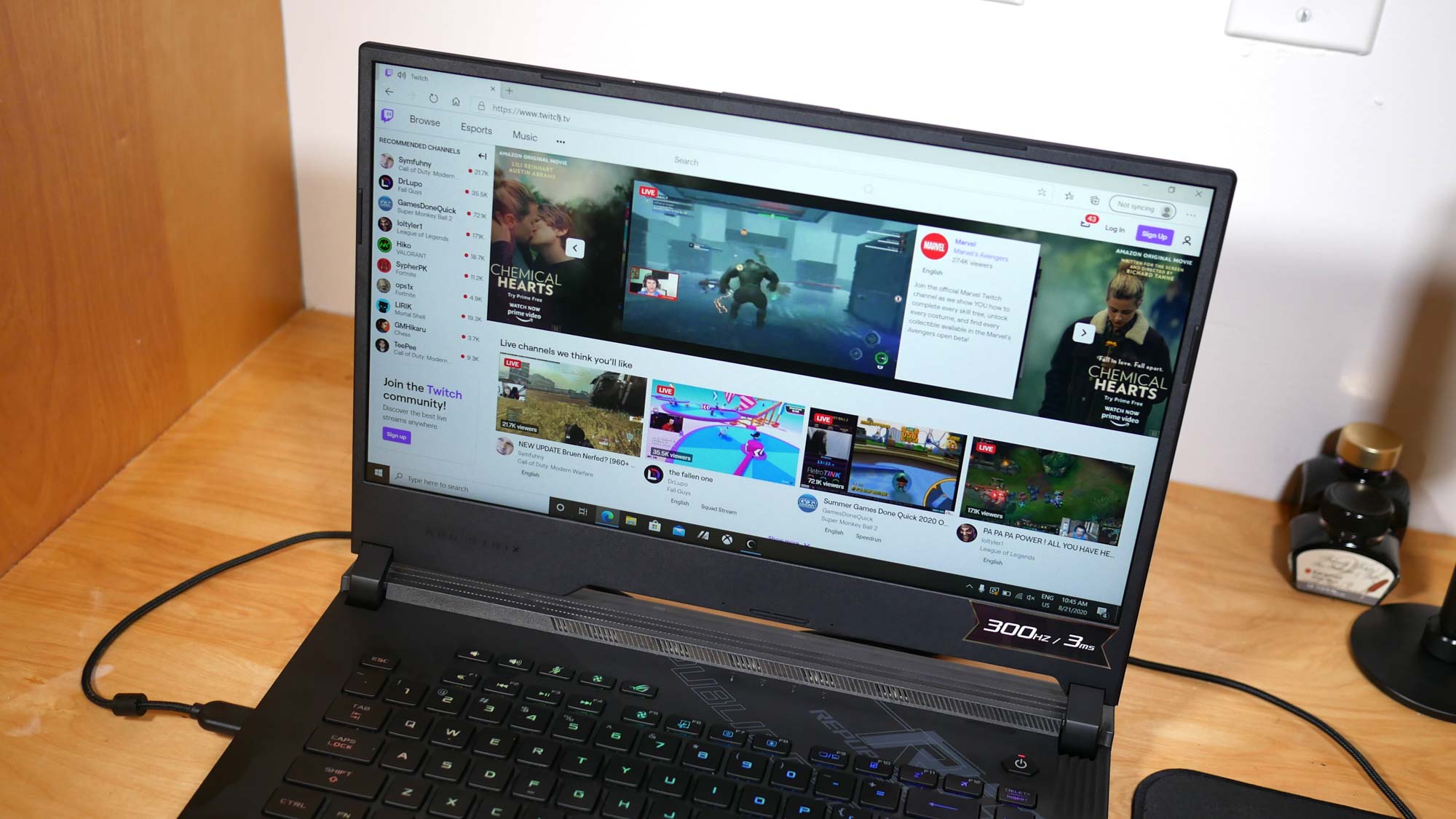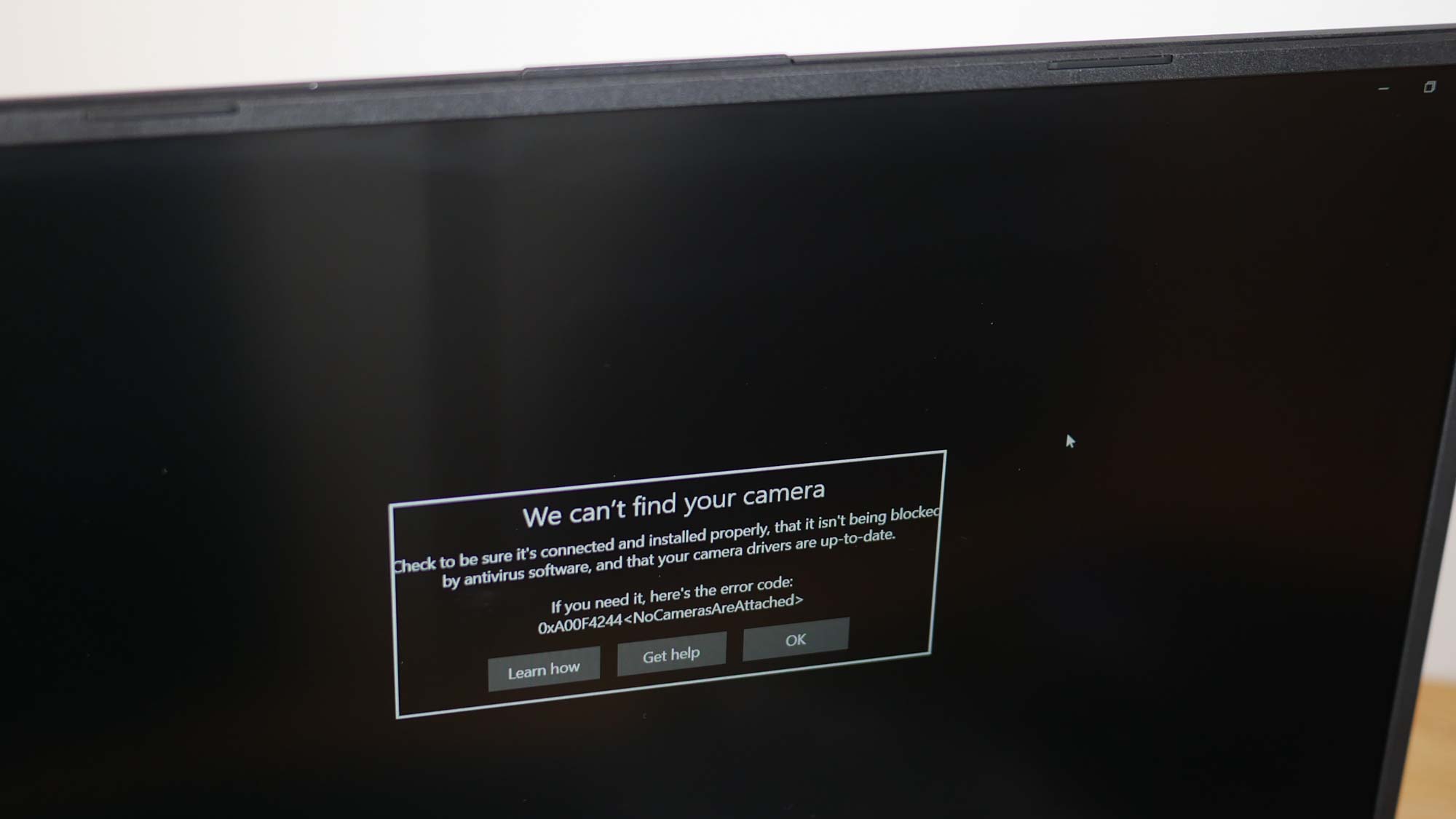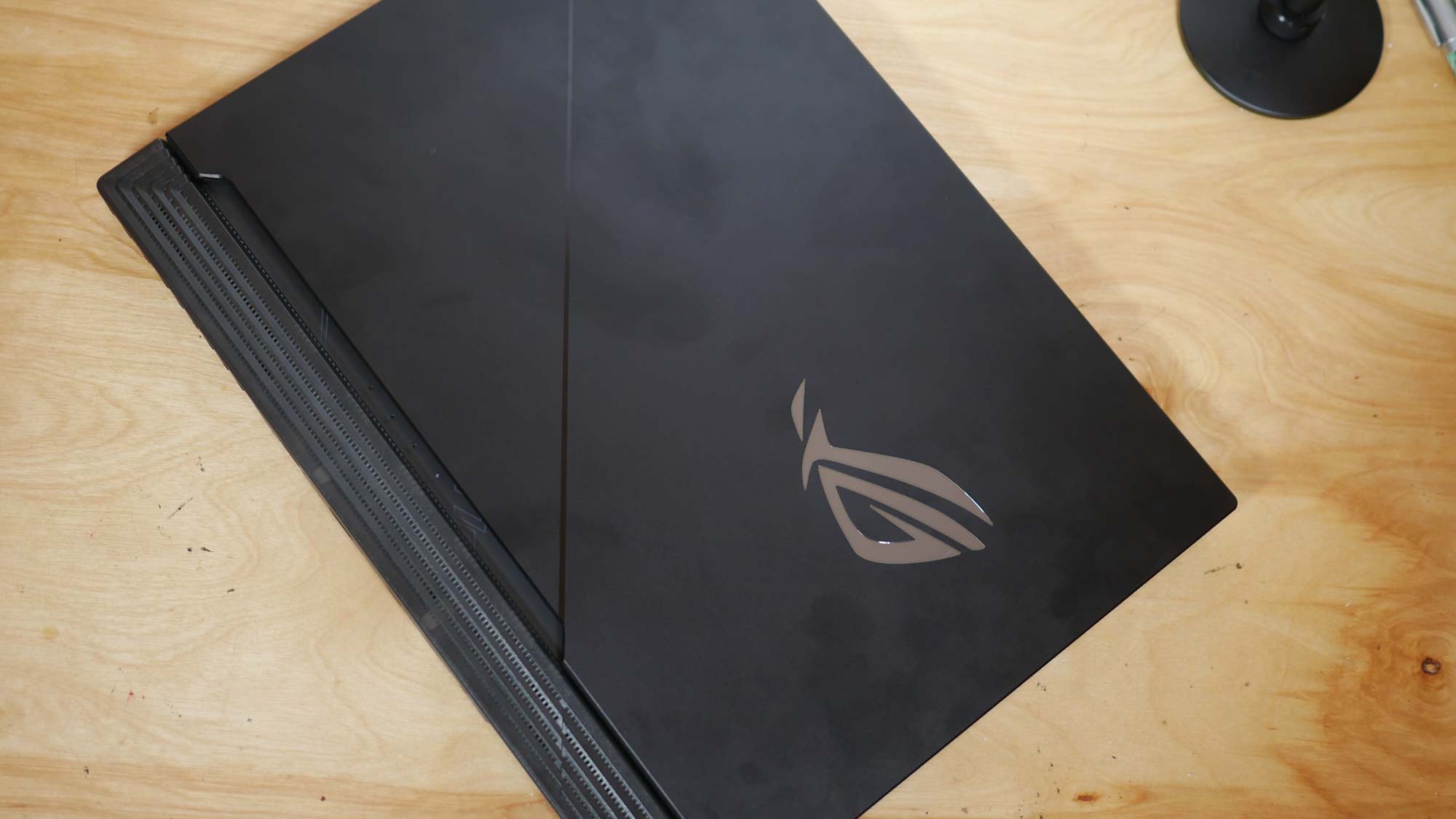Laptop Mag Verdict
Asus' ROG Strix Scar 15 is a great option for aspiring e-sports gamers thanks to its 300Hz display, comfortable keyboard and incredible performance.
Pros
- +
Attractive chassis with gorgeous RGB
- +
Vivid 300Hz display
- +
Outstanding overall performance
- +
Comfortable keyboard
- +
Unique soft-touch palm rest
Cons
- -
Dim display
- -
Fans get loud
- -
No Thunderbolt 3 port
- -
No webcam
Why you can trust Laptop Mag
Price: $2,499
CPU: Intel Core i9-10980HK
GPU: Nvidia GeForce RTX 2070 Super
RAM: 32GB
Storage: 2TB
Display: 15.6-inch, 1080p, 300Hz
Battery: 4:31
Size: 14.1 x 10 x 0.7 inches
Weight: 5.7 pounds
Designed for esports competitors and what Asus calls "Core gamers," the ROG Strix Scar 15 (reviewed at $2,499) is a powerful gaming rig with the latest display technology. Under the hood is a beastly Intel Core i9-10980HK CPU and the capable Nvidia GeForce RTX 2070 Super GPU, a combo that will let you play the latest AAA games at high frame rates even at Ultra graphics settings.
Power isn't an issue with ROG Strix Scar 15 nor is its gorgeous design, which blends stealthy black surfaces with mesmerizing RGB effects, from the colorful per-key lights to the underbody light bar. For all the pizazz of those glowing lights, the standout feature of the ROG Strix Scar 15 is the 15.6-inch, 1080p display and its superfast 300Hz refresh rate — a welcome feature for those who need instant feedback when playing at the highest levels of competition.
If only the display wasn't so dim and the fans didn't get so loud when the laptop was being pushed to its limits. It's also hard to overlook the lack of a webcam and Thunderbolt 3 port. Regardless, the Strix Scar 15 is a great gaming laptop for those who need a powerful rig and the fastest display.
Pricing and configurations
Our ROG Strix Scar 15 was decked out with an Intel Core i9-10980HK CPU, 32GB of RAM, a 2TB SSD and an Nvidia GeForce RTX 2070 Super GPU with a 1080p, 300Hz display. It is available on Amazon for $2,499 after a $300 discount.
If you don't want to spend so much, the $1,999 base model comes with an Intel Core i7-9750H CPU, 16GB of RAM, a 1TB SSD and an RTX 2070 GPU with a 240Hz display. There is a middle option for $2,499 with a Core i9 CPU, 16GB of RAM, a 1TB SSD and an RTX 2070 Super GPU with a 300Hz panel.
Design
Fireworks look best at night. Using this principle, Asus opted for a blackout look on the ROG Strix Scar G15 so the RGB light bar underneath could shine bright. The effect is captivating; rainbow colors filled my dark office space, beaming yellows, purples, pinks and yellows across my desk.
Sign up to receive The Snapshot, a free special dispatch from Laptop Mag, in your inbox.
I get a cruel satisfaction imagining my esports rival cowering in fear as the Strix powers up. On the other hand, I wouldn't want to use this flashy laptop in a formal setting with colored lights shooting out of it from all ends. Fortunately, you can turn the light bar off using the Aura Creator app if you don't want so much attention.
Try to ignore the light show and you'll appreciate the ROG Strix Scar 15's stealthy chassis. The lid trades a gaudy gamer aesthetic for a simple matte-black surface with a single diagonal line cutting across the center. Again, Asus lets the color do the talking with a ROG logo that illuminates various hues. A cutout on the bottom of the lid lets you peek at four LED indicators for Airplane mode and battery, Wi-Fi and SSD status.
There is no ignoring the Strix Scar 15's intended purpose as a laptop for esports gamers once you open the lid. Tattooed on the right side of the deck is a gray Republic of Gamers decal. It combines with interesting textures -- ribbed lines along the right side and stipples on the spine -- to give the Scar 15 a youthful aesthetic. Rising up from that deck are RGB-illuminated keys that, like the light bar below the deck, glow limitless hues.
RGB color profiles can all be saved onto the Keystone II, a physical NFC-enabled USB-type fob that inserts into the right side of the laptop. This way, you can keep your favorite lighting effects, along with personalized settings, the ability to quick-launch apps or reveal a "shadow drive" for private storage. It's a novel idea, but I'm not convinced yet because very few Asus laptops support the Keystone.
Instead of the traditional plastic materials used on most gaming laptops, the Strix Scar 15 has a pleasant soft rubber coating that felt cushy against my palms. The rest of the laptop is made of plastic but it feels pretty solid, as do the hinges. I do wish Asus had trimmed down the bottom bezel to match the slim frames around the top and sides of the display.
At 14.1 x 10 x 0.7 inches and 5.7 pounds, the ROG Strix Scar 15 is thinner but heavier than the HP Omen X 2S (14.3 x 10.3 x 0.8 inches, 5.2 pounds) and the MSI GE66 Raider (14.1 x 10.5 x 0.9 inches, 5.3 pounds). The Acer Predator Triton 500 (14.1 x 10 x 0.7 inches, 4.8 pounds) is the most portable laptop in this class.
Ports
You get a good selection of connections apart from one inexcusable omission: Thunderbolt 3.
On the left side are a headphone jack and three USB 3.1 Type-A ports for connecting your peripherals, like a mouse and keyboard. I wish one of those inputs was on the right side so I didn't have to run my mouse wire behind the laptop.
As much as I dislike rear-facing ports, the ones on the Strix Scar G15 all belong there. On the back are an RJ-45 Ethernet port, an HDMI 2.0, a USB Type-C input w/ DisplayPort and an AC power adapter.
The right side of the laptop is bare except for the Keystone II housing.
Display
The highlight of the ROG Strix Scar G15's 15.6-inch, 1080p display is the 300-hertz refresh rate, which makes fast-action games look buttery smooth.
As a quick reminder, refresh rate refers to how many times a panel updates in a second -- the higher the number, the better it can keep up with fast motion. At 300Hz, this is the fastest panel we've ever tested, providing a near latency-free gaming experience.
Having a refresh rate of 300Hz is useful for esports gamers who need instant feedback, but most people won't notice the difference between 144Hz and 300Hz. Then there's the problem of hardware: in order to benefit from a 300Hz panel, you need a GPU that can run games at high frame rates. Thankfully, the ROG Strix Scar 15 has one (more on that later).
I enjoyed gaming on the superfast panel, which exhibits accurate and vivid colors. I only wish it got a bit brighter so it was easier to see outdoors or in bright rooms, although the matte finish helps reduce reflections.
When I played Shadow of the Tomb Raider, red and yellow tapestries hung on the walls of a tribal village were bursting with color while blue hand paintings looked like they had been freshly slathered on the clay walls. The game looked gorgeous on Ultra settings; I could see the tassels hanging from Lara Croft's patterned dress and the leaves of a tree in the distance.
The panel kept up with my rapid movements even when I dropped the graphics to low and played at 160 fps -- I couldn't perceive much of a difference between it and a 144Hz display but previous side-by-side comparisons proved that those super-high refresh rates are worthwhile for certain gamers.
According to our colorimeter, the ROG Strix Scar 15's display covers 112% of the sRGB color gamut, making it more colorful than the panel on the Omen X 2S (107%). The GE66 Raider (114%) and Predator Triton 500 (117%) have displays that get a bit more vivid, but probably not enough to notice.
My biggest complaint with the Scar 15's display is that it doesn't get very bright, reaching only 278 nits. It's a complaint I've flagged with several recent Asus models so Asus, if you're listening, please work on this. As proof, the Omen X 2S reached 306 nits and the GE66 Raider hit 300 nits at 100% brightness. The Predator Triton's screen was the dimmest at 277 nits and we knocked it accordingly.
Keyboard and touchpad
The Chiclet-style keyboard on the Strix Scar 15 feels great. My fingers, assisted by the springy switches, pranced from one key to the next as I solved a tricky puzzle in Shadow of the Tomb Raider.
I'm pretty particular when it comes to keyboards, but there's nothing I dislike about this one. The keys are appropriately sized and spaced properly so I felt right at home the moment I started using the Strix Scar 15. The keys offer a decent amount of travel and I even like the layout -- the arrow keys are isolated in an inverted-T while the shortcut keys are grouped together and the volume/mic and fan controls are located above the shortcut row.
The keys are per-key RGB backlit and while the lighting isn't perfectly uniform across each key, the effects available in the Aura Creator app are captivating. I especially like the Rainbow setting as it displays the full gamut of colors available on these keys.
I typed at 119 words per minute with a 97% accurate rate, which matches my normal speed but with fewer than my usual 5% errors.
The 4.4 x 2.7-inch touchpad on the Scar 15 didn't give me any problems as I swiped across web pages and executed Windows 10 gestures like pinch-to-zoom and three-finger swipe to switch windows. The digital numpad overlaid on the touchpad is a clever feature and works well, although I accidentally turned it on a few times by tapping the top-right corner of the smooth surface.
Audio
The side-firing speakers on the front of the Strix Scar 15 sound great unless you're a basshead.
When I listened to Duñe's "She's Not," the relaxing vocals were surprisingly crisp and the trebly guitars pierced through the drum kicks. The instruments and vocals were all nicely balanced, but again, the bass was a soft thud instead of a low rumble. In Glass Animals' "Domestic Bliss," the speakers captured the restrained anger in Dave Bayley's voice and I could hear the complex layering of instruments in the chorus.
The string of a bow sounded as if it were being pulled back next to my ear before it sailed through my enemy when I played Shadow of the Tomb Raider. The sound of crickets chirping and birds whistling added to the sense that I was traveling through a dense jungle. However, the tribal music playing in the background while I wrestled with a puzzle lacked the bass needed to do justice to its thudding drum beat. Fortunately, the speakers were loud enough to hear over the blaring fans, even when cranked at full speed.
Gaming, graphics and VR
Armed with an Nvidia GeForce RX 2070 Super GPU with 8GB of VRAM, the ROG Strix Scar 15 is ready to play even the most demanding games. I maintained a smooth 80 frames per second when playing Shadow of the Tomb Raider with the settings set to Ultra and the resolution at 1080p.
On the Grand Theft Auto V test (1080p, Ultra), the ROG Strix Scar 15 nailed 86 fps, outpacing the Omen X 2S (81 fps, RTX 2080 Max-Q), the Predator Triton 500 (60 fps, RTX 2080 Max-Q) and the average premium gaming laptop (85 fps).
It did similarly well in Far Cry New Dawn, speeding to 90 fps, which embarasses the Omen X 2S (61 fps), but loses out to the GE66 Raider (99 fps). The average premium gaming laptop plays Far Cry at 86 fps.
And finally, the ROG Strix Scar 15 had no problem playing the demanding Red Dead Redemption 2 at 1080p resolution, doubling our playability threshold with an excellent 60 fps. That edges out the GE66 Raider (58 fps) and the category average (54 fps).
Performance
Equipped with a top-of-the-line Intel Core i9-10980HK CPU with 32GB of RAM, the ROG Strix Scar 15 shrugged its shoulders as I loaded up 25 Google Chrome tabs. YouTube videos blinked into existence, my favorite websites flashed to life and Twitch streams instantly appeared the moment I pressed "enter" in the URL line. Even light photo editing in Affinity Photo didn't cause the Scar 15 to stutter with all of those tabs running in the background.
On the Geekbench 4.3 overall performance test, the Scar 15 scored an outstanding 32,870, crushing the Omen X 2S (23,019, Core i7-9750H), the GE66 Raider (32,767, Core i9-10980HK), the Predator Triton 500 (20,990, Core i7-8750H) and the category average (28,219). With a score of 8,263 on the more demanding Geekbench 5.0 test, the Asus fell just short of the GE66 Raider (8,379) but topped the average (7,514).
It took the Scar 15 only 7 minutes and 26 seconds to convert a 4K video to 1080p resolution using the Handbrake app. Only the GE66 Raider (6:59) beat that time while the Omen X 2X (10:26), the Predator Triton 500 (11:04) and the category average (8:27) lagged far behind.
The Scar 15 also has a very speedy SSD. The 2TB drive on our review unit duplicated a 5GB multimedia file in just 3 seconds at a transfer rate of 1,542.2 megabytes per second. The Omen X 2S was half as fast (848 MBps, 1TB NVMe SSD) while the GE66 Raider (1,458.2 MBps, 1TB NVme PCIe SSD) and the average premium gaming laptop (1,053.89 MBps) also fell short. However, the Predator Triton 500 (1,696.4 MBps, dual 512GB NVMe PCIe SSD) won this round.
Battery life
Gaming laptops are at ease when they're tethered to an outlet and the Strix Scar G15 is no exception. With a runtime of 4 hours and 31 minutes, the Asus battery life failed to hit the category average (4:51) or the MSI GE66 Raider's 4:57 runtime by a few minutes.
It's not all bad news. The ROG Strix Scar G15 outlasted other beastly RTX-equipped gaming rigs, like the HP Omen X 2S (2:20) and the Predator Triton 500 (3:04).
Heat
You could almost cook an egg on the Strix Scar 15. The right side of the deck reached a scolding 135 degrees Fahrenheit in our gaming heat test, which involves five loops of the Metro: Exodus benchmark. The underside of the laptop, at 115 degrees, and the center of the keyboard, at 111 degrees, also breached our 95-degree comfort threshold. Only the touchpad was a reasonable temp and you'll probably use a mouse anyway.
We didn't have as many problems on our standard video playback heat test where we play a 1080p YouTube video for 15 minutes. The bottom panel ran a mild temperature of 100 degrees while the touchpad and keyboard were comfortable to the touch.
Webcam
"We can't find your camera" the Windows 10 camera app politely notified me when I tried to snap a selfie. Oh yeah, that's right, Asus doesn't put an integrated webcam on some of its gaming laptops. The ROG Strix Scar 15 is one of them -- above the display is a thin plastic bezel with no lens in sight.
Asus figures most gamers will use a webcam for streaming and integrated solutions just aren't good enough. While I tend to agree, It'd be nice to have an external webcam included in the box, especially at this price. Instead, you should pay an extra $80 or so for the Logitech C920 when it goes back on sale.
Software and warranty
Gamers should be aware of two pre-installed apps on the Strix Scar 15: Armoury Crate and Aura Creator. Armoury Crate is your go-to software for tinkering with settings and features.
You can check your CPU, memory and storage status, adjust your fan speeds, change your screen color to different presets and even find game deals on Steam. There is also an Aura Sync setting for basic RGB customization. I preferred using this instead of the Aura Creator app because it's much easier to choose different colors, patterns and effects. However, if you want set per-key lighting, you can do so with Aura Creator, which uses a timeline system similar to a video editor.
Asus also includes a GameVisual app for quickly adjusting the display mode using one of eight presets, which include Racing, Scenery, FPS and Cinema. For support, driver updates and technical info, you can use the MyAsus app, which is included on all modern Asus laptops.
And, of course, you'll find the standard fare of Windows 10 Pro apps, which includes McAfee Personal Security, Microsoft Solitaire Collection and the Your Phone app.
Asus ships the ROG Strix Scar 15 with a one-year warranty. See how Asus fared in our Tech Support Showdown and Best and Worst Brands special reports.
Bottom Line
The ROG Strix Scar 15 is a powerful gaming laptop with the fastest display you'll find on a laptop. It has a gorgeous display with loads of RGB lighting and an excellent keyboard that will give you an edge whether you're in an FPS firefight or drifting corners in a racing game. The combination of a Core i9 CPU and RTX 2070 Super GPU means you can play the latest titles at maximum graphics or do video- and photo-editing when you're streaming for your fans.
It's a shame that the laptop's shortcomings are largely preventable. There is no excuse for a laptop at this price to not include a Thunderbolt 3 port or a webcam (an external webcam would be fine). I also wish the display got brighter so you could take advantage of the 300Hz refresh rate without wanting to connect to a brighter monitor. The fans also get very loud while gaming so get yourself a good pair of headphones to block out the whine.
All things considered, the ROG Strix Scar 15 is an impressive gaming laptop with bountiful power, a beautiful chassis and a superfast display.
Asus ROG Strix Scar G15 Specs
| Size | 14.1 x 10 x 0.7 inches |
| Display | 15.6-inch, 1080p, 300Hz |
| CPU | Intel Core i9-10980HK |
| Price | $2,499 |
| GPU | Nvidia GeForce RTX 2070 Super |
| Battery | 4:31 |
| Weight | 5.7 pounds |
| Storage | 2TB |
| RAM | 32GB |
Phillip Tracy is the assistant managing editor at Laptop Mag where he reviews laptops, phones and other gadgets while covering the latest industry news. After graduating with a journalism degree from the University of Texas at Austin, Phillip became a tech reporter at the Daily Dot. There, he wrote reviews for a range of gadgets and covered everything from social media trends to cybersecurity. Prior to that, he wrote for RCR Wireless News covering 5G and IoT. When he's not tinkering with devices, you can find Phillip playing video games, reading, traveling or watching soccer.

